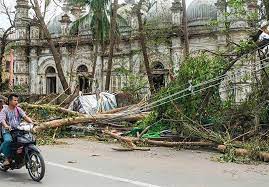
Cyclone Hamoon made landfall in southeastern Bangladesh, prompting the evacuation of nearly 275,000 people, and claiming the lives of at least two individuals as it battered the coastal regions. The low-lying South Asian nation, Bangladesh, has been grappling with a growing number of severe weather events, partly attributed to the impact of climate change, which intensify the size and impact of storms.
While there have been no widespread reports of major damage, Cyclone Hamoon has taken a toll on the region. Power lines were disrupted, and coastal villages and islands faced heavy rainfall, causing residents to seek refuge in cyclone shelters. Kamrul Hasan, secretary of the disaster management ministry, reported that two individuals lost their lives during the storm – one due to a fallen tree and the other because of a building collapse. Ten additional people sustained injuries and are currently receiving medical attention in hospitals.
Bangladesh Meteorological Department expert Muhammad Abul Kalam Mallik noted that Cyclone Hamoon made landfall in the Chittagong and Cox’s Bazar coastal districts, accompanied by wind speeds reaching up to 104 kilometers (65 miles) per hour. Mallik further stated that the cyclone is expected to move inland and gradually weaken.
Notably, the southeastern coast of Bangladesh is home to nearly one million Rohingya refugees who have sought shelter from Myanmar. These refugees reside in fragile tarpaulin shelters, but fortunately, the main path of Cyclone Hamoon did not directly impact their camps.
However, Cox’s Bazar district experienced a power outage late Tuesday, making it difficult to obtain immediate updates on any damages sustained. Climate change experts point out that the increasing intensity of tropical storms, along with greater rainfall and stronger winds, contributes to flash floods and coastal destruction. Cyclone Mocha in May became the most powerful storm to strike Bangladesh since Cyclone Sidr in November 2007, an event that resulted in more than 3,000 casualties and substantial economic losses.
In recent years, improved forecasting and more effective evacuation planning have contributed to significantly reducing the death toll associated with these storms. However, the growing frequency of severe weather events remains a major concern for Bangladesh’s coastal regions.
Sources By Agencies




